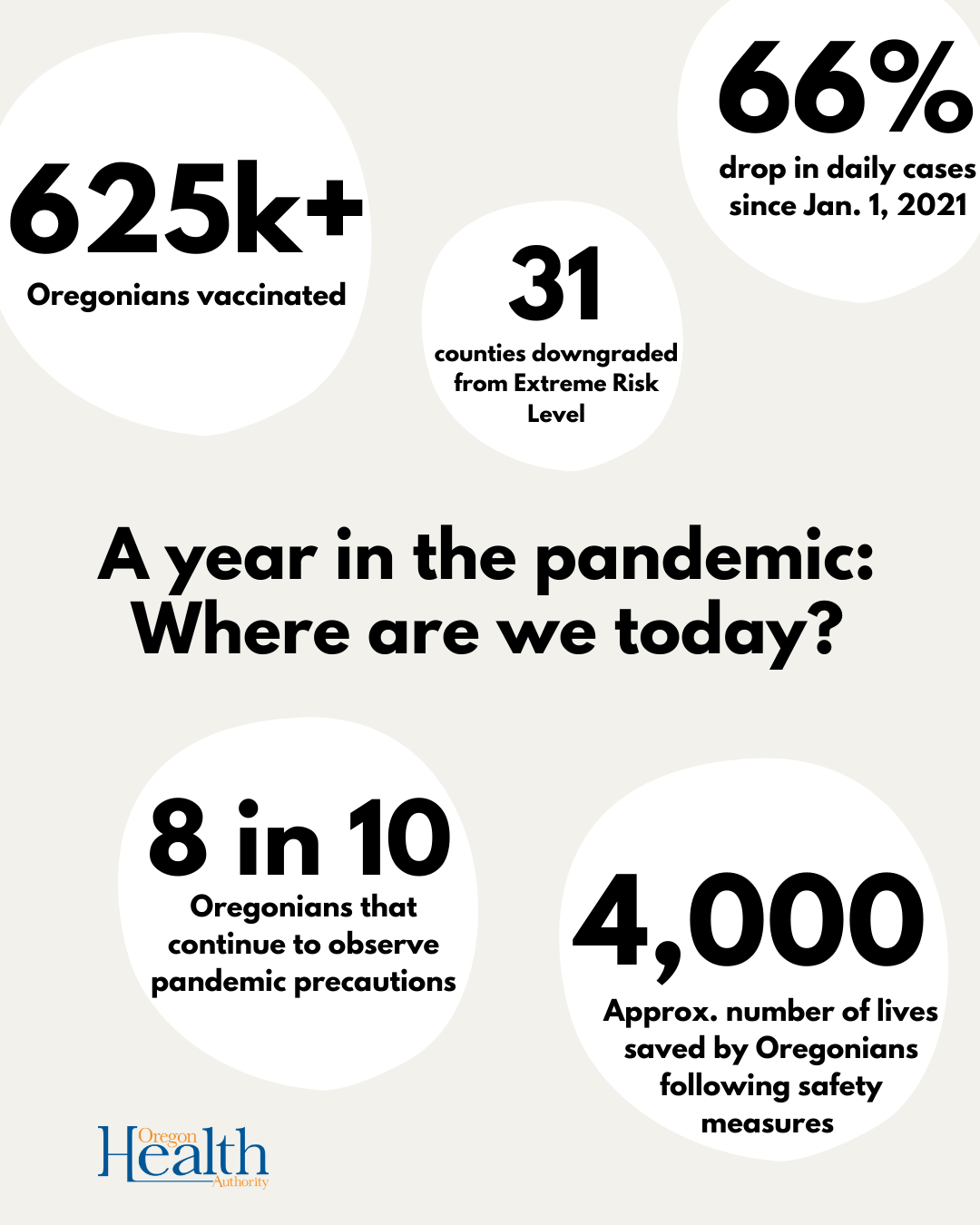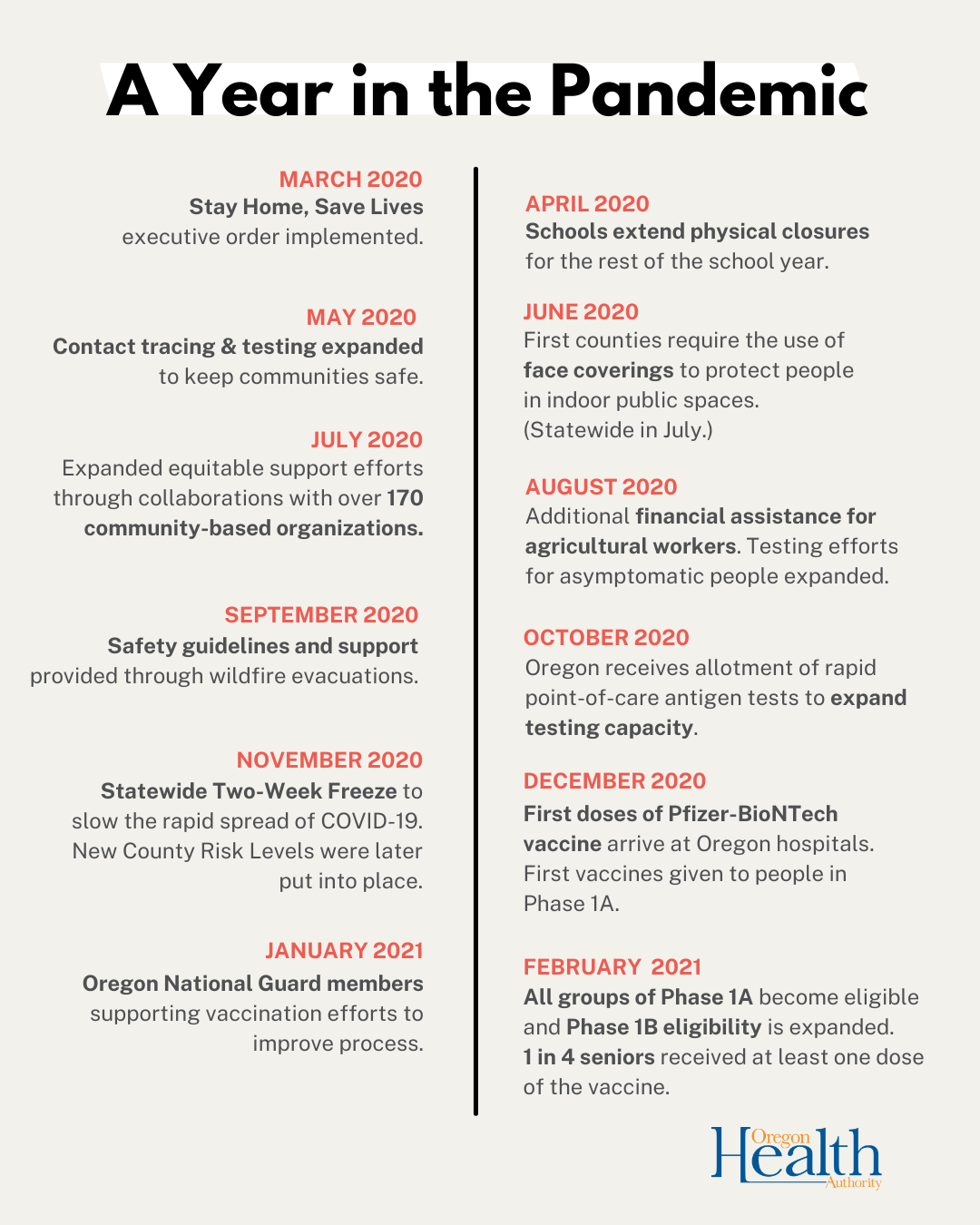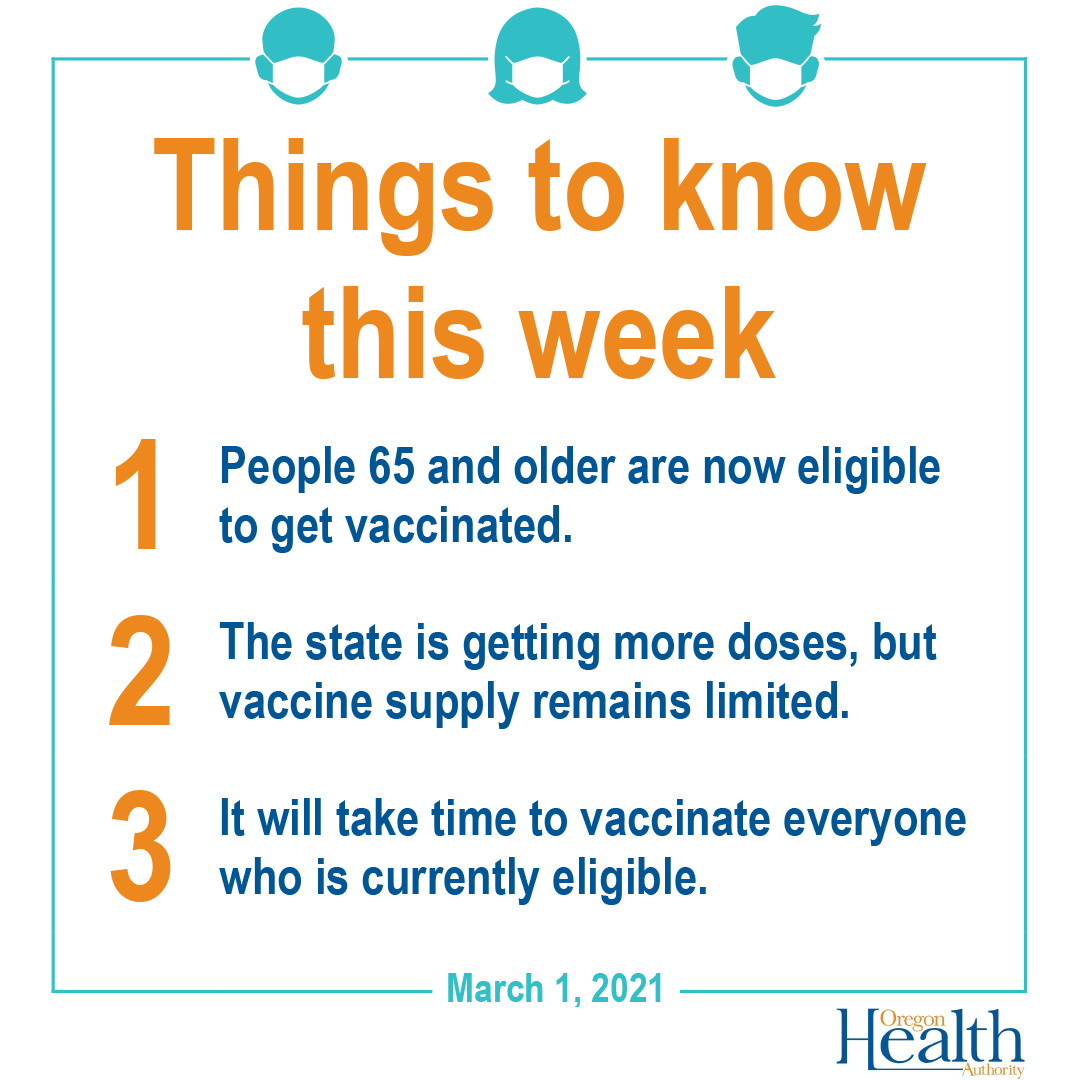As of yesterday, it’s been one year since the first case of COVID-19 was diagnosed in Oregon. Twelve grim months later, nothing is the same. The pandemic has claimed more than half a million lives in the United States. More than 2,200 Oregonians have died with the coronavirus. All of us have felt their loss. All of us have seen our lives altered: a beloved grandparent’s lonely wave through the glass of a nursing home window. The empty storefront of a bedrock local business. Birthdays, graduations and anniversaries awkwardly celebrated on a screen instead of in-person. Frustration as parents struggle to help kids in school while trying to meet work demands.
But there’s another number Oregonians should bear in mind, especially as we confront the coming months of the pandemic: 4,000. That’s approximately the number of lives you’ve saved by wearing a mask, limiting in-person gatherings and maintaining social distance.
Oregon was one of the first states in the nation to report a case of COVID-19, but a year later our state has the fourth lowest coronavirus case rate in the nation, the fourth lowest death rate and the fourth lowest COVID-19 death rate among seniors. If Oregon’s death rate matched the nation’s, three times as many Oregonians would have lost their lives.
You made the difference. Month after month, deep into the pandemic, about 8 in 10 Oregonians continue to observe lifesaving pandemic precautions. While we know who’s died from COVID-19 – in ages ranging from under 1 to more than 100 years old – we’ll never know for sure whom you’ve saved. Maybe it’s an esteemed elder who’s alive to lead a virtual devotional group for his faith community. A middle-age mother who’s here to help her daughter apply for college. A thirtysomething who agrees to be best man at his friend’s wedding, once the pandemic is over. Maybe it’s someone reading this message. Maybe it’s you.
State and local public health actions saved lives too. Governor Kate Brown issued early stay at home orders. Our state was the first in the nation to protect the most vulnerable nursing home residents by limiting visitation. Oregon put limits on bars, restaurants, gyms and other types of businesses that could fuel the virus’ spread. Those limits figured as vital factors in Oregon’s life-saving calculus – but they came with undeniable costs to workers and business owners. Still, and unlike other states, Oregon kept manufacturing and construction going, blunting the worst-case economic fallout on working families.
Here’s another number: 986,816. That’s the number of COVID-19 vaccine first and second doses Oregon nurses and other vaccinators have administered so far, as of today. It’s true Oregon’s vaccine rollout has been as bumpy as it has been elsewhere. Yet Oregon has fully vaccinated about 1 in 12 adults, putting us ahead of most other states (Oregon ranks 16th in the percent of people fully vaccinated).
But the pandemic isn’t over. More contagious and more dangerous variants of the virus are taking hold. We are in a race to vaccinate as many people as possible, as soon as we can.
It’s been a hard year. On top of the pandemic, we’ve endured historic wildfires that also claimed lives, displaced thousands and obliterated the homes and businesses that comprised entire communities. We’ve awakened to an overdue reckoning with racial injustice – including unacceptable health inequities. Winter storms compounded our discomfort and disruption.
We’re tired. But we can’t give up.
With gratitude, and respect for all the lifesaving sacrifices you’ve made so far, I ask Oregonians to:
- Keep wearing masks, limiting your social get-togethers and maintaining your physical distance. Until we know more, we need to keep our guard up.
- Choose to get vaccinated when you are eligible, as soon as an appointment is available to you.
On Friday, Governor Brown told Oregonians we are speeding up our timelines to vaccinate Oregonians. Over the next month we expect to vaccinate more than 3 in 4 seniors. People with underlying health conditions will be eligible on March 29. Frontline workers will be eligible no later than May 1. And we’ll open vaccinations to the first healthy members of the general public no later than June 1.
I know many people have questions about COVID-19 vaccines. I know the experience of racism and memories of historical trauma and medical experimentation are alive in many communities. Other people are wary of government.
Yet once again, we depend on each other to save lives. The COVID-19 vaccine is the safest and most effective way to protect yourself and your loved ones and return to more of our normal life. We need enough Oregonians to get immunized, so all of us are protected.
Thank you for the lives you’ve saved so far and the lives we can all save in the months to come.


Community-Based Organizations: ‘experts in their experiences’
One of the key ways OHA has responded to the pandemic is to partner with and provide funds to the groups that know their communities best. Last July, OHA launched a statewide program to fund Community Based Organizations (CBOs) to respond to COVID-19.
The CBOs are in every Oregon county and have deep ties to the communities they serve: older adults, communities of color, tribal communities, people with disabilities, people with limited English proficiency, low income people and those experiencing homelessness. In other words, communities that are bearing the brunt of the pandemic.
More than 170 CBOs receive CARES Act funds to do work in these areas:
- Outreach and community engagement
- Contact tracing together with local public health authorities
- Providing people with social services/wraparound supports
“Communities know best what will work for them; they are the experts in their experiences,” says Kristen Darmody, equity policy analyst at OHA. “They have the best sense of how current systems and processes have failed them, and they have ideas and energy around what will work for their communities.”
That might be providing rent assistance or culturally specific food boxes to people who need to isolate or quarantine, helping rural seniors access vaccines, or hosting COVID-testing events.
Or it might be sharing safety information about COVID-19 in culturally and linguistically responsive ways like these:
- Fact sheets about how to stay safe in a pandemic are printed in 11 languages and handed out by trusted community members to agricultural workers who may have no internet access and be wary of government.
- “Can you smell this?” That’s the question, written in Russian, on one side of air fresheners that dangle from rearview mirrors. The other side lists the symptoms of COVID-19 (besides potential loss of taste and smell).
“CBOs and faith-based organizations are out there on the ground, doing the work, making a difference in people’s day-to-day lives,” says Darmody.
Look for more stories about the important COVID-19 work done by CBOs and other partners in future issues of Coronavirus Update.
Things to Know: 65+ now eligible; Vaccine Information Tool (chatbot) is now updated
Starting today, people who are 65 and older are eligible for the vaccine. To offer some time to vaccinate those who eligible but still waiting for vaccination, this will be the last new group eligible for vaccination for a couple of weeks.
Due to limited supply, not everyone who is eligible will be included on the weekly list. All eligible groups who want a vaccine will get a vaccine over the coming months.
If you’re trying to book an appointment, you may notice that OHA and All4Oregon have changed the process for scheduling appointments at the Oregon Convention Center.
How it works:
- Today, adults who are 65 and older, and most others who are eligible for vaccines in Phase 1A in the Portland metro area, will no longer be directed to the chatbot to schedule appointments at the Oregon Convention Center.
- All Oregonians, including adults age 65 and older, can sign up to receive notification about vaccination events when they are eligible by using the Get Vaccinated Oregon (GVO) signup tool at covidvaccine.oregon.gov.
- The new appointment scheduling process for eligible older adults who live in Clackamas, Columbia, Multnomah or Washington counties will be based on names being pulled from the Get Vaccinated Oregon tool.
- On a weekly basis, OHA will use that GVO tool to electronically scramble the names of all eligible older adults in the metro area. OHA will then send a list of names to All4Oregon that matches the number of vaccination appointments available for scheduling.
- All4Oregon will contact individuals to schedule their appointment.
Changes do not apply to the following:
- People with mobility issues, who will continue to be able to access appointments at the Portland Airport Red Economy Parking Lot drive-thru clinic through the chatbot.
- Educators in the Portland metro area and people who live in Marion County can continue to find appointments through the Vaccine Information Tool.
- People who have already scheduled vaccine appointments at the Oregon Convention Center, the Portland Airport or the Legacy Woodburn Health Center.
As more vaccines become available, vaccine distribution sites will expand to more locations, such as retail pharmacies, outpatient clinics and other sites linked to hospitals and health systems.
For help understanding the scheduling options, call 211.
Oregon to receive Johnson & Johnson vaccine
Johnson & Johnson’s single-dose vaccine has received an Emergency Use Authorization (EUA) from the federal government, making it the third COVID-19 vaccine available for use in the United States.
The Johnson & Johnson vaccine is the first single-dose vaccine against COVID-19. It can be stored in a refrigerator for months, making it easier to distribute without the need for ultra-cold storage.
“Having access to a third highly effective COVID-19 vaccine is a game-changing development for Oregonians,” said Paul Cieslak, M.D, medical director for communicable diseases and immunization, OHA Public Health Division. “We believe this vaccine is effective against the virus, and a one-dose regimen will allow us to vaccinate more Oregonians more quickly.”
The process for the Johnson & Johnson vaccine review and approval was the same as it was for the Moderna and Pfizer vaccines. The company submitted its application for EUA on Feb. 4.
In its review of Johnson & Johnson’s application, the FDA reported the vaccine was 66% effective for moderate to severe/critical COVID-19 in all groups across all regions studied starting at 28 days after vaccination. The observed efficacy in the United States was 72%. The clinical trial involved 43,783 participants in the United States, Latin America, Brazil and South Africa.
“The best thing is that this one-dose vaccine was 85% efficacious in preventing severe COVID-19,” Dr. Cieslak said.
Reported vaccine side effects include pain at the injection site, mild to moderate headache, fatigue and muscle aches.


